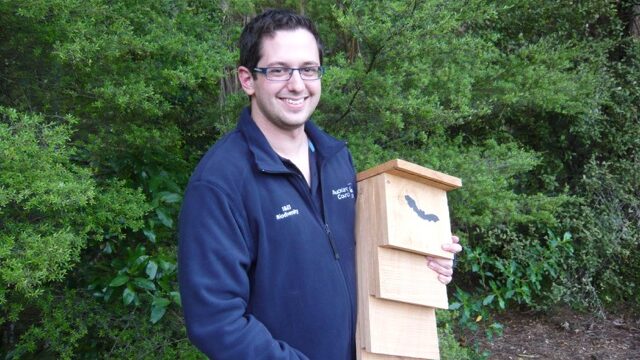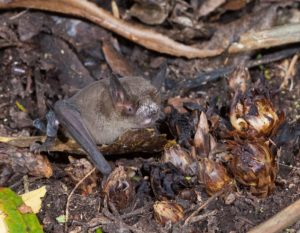Auckland Council biodiversity officer Ben Paris, aka NZ Batman, is on a mission; not to save Gotham by defeating criminal masterminds, but to protect our bat population (yes, we have bats) through education and conservation. Here, he takes on our bat questions.

‘NZ Batman’… was that title self-coined?
This is an occupational hazard of working with bats! I always get called Batman by people I meet. I believe it’s better to embrace the name for the sake of the bats, plus it’s pretty cool taking on a superhero persona.
How did your love of bats come about?
I started working with bats in Hamilton, where there’s a population right in the middle of suburbia by the Waikato River. We created a bat brand called Project Echo and started by taking a school holiday programme from Waikato Museum to look for bats at night. When we heard and saw bats flying around us, the kids’ faces just lit up with excitement and I knew I wanted to share these kind of experiences with as many people as I could.
How many bat species are left in NZ? What makes them unique/special?
Two of the three bat species are left in NZ. These are both unique to New Zealand, were the only native mammals before humans arrived, and have some pretty special roles in our ecosystems. The short-tailed bat roams the ground like a mouse, eating invertebrates, seeds, pollen and fruit, but is also a pollinator of our native plants like pohutukawa, nikau and dactylanthus (wood rose). The long-tailed bat is an aerial insectivore, gobbling up flying insects like moth, mosquitoes and midges – quite useful for us to have around in the summer!
NZ long-tailed bats are one of your key focuses. What do you do to keep the numbers up?
Habitat loss is one of the biggest threats to bats. The most important focus for us is finding where the long-tailed bats are. By contributing data to our bat map, we are able to give advice as to what areas are likely to be “bat-sensitive” when it comes to vegetation clearance or housing development projects. If we can get some gains by protecting areas of bat habitat, accompanied with good pest control, we should be able to keep the numbers up.
Which predators are the biggest threat to bats? How do you control them?
The same mammalian pests that plague our birds and lizards also threaten our bats. We use a mixture of bait stations and traps depending on the situation to protect bats. In one local reserve we just use traps, while in our regional parks we have an extensive bait station network. Rats and possums are the easiest to trap in your backyard, and this can make a significant difference to the biodiversity you see around your place.
How do you raise funds for the resources you need or is it all council-funded?
So far most bat monitoring has been funded by Auckland Council, or grants from the local boards where bats have been found. As we find more bats, local boards have been open to funding more community projects to find other populations. We have also used donations at bat awareness events to fund community bat detectors.
What milestones have you achieved so far? What are you proudest of?
In 2013 we ran our first Bat Fun Day in a local park where bats had been found.
Over 400 people from all over Auckland turned up to take part in bat kites, bat belts, bat colouring-in, bat cookie sales and bat educational talks. It was truly amazing.
Since then, word has spread and I’ve had some pretty amazing experiences talking about bats overseas, doing radio interviews, and even making some bat documentaries.
What’s been the biggest challenge?
Probably the biggest challenge is trying to overcome the ‘bad bat’ myths out there. From vampire bats, to getting caught in your hair; there seems to be a fear of bats throughout most cultures. Even in Maori culture, bats are known as foreboding bad times ahead. My challenge is to try and get people to see bats in a positive light, and having them realise we can live with bats in our environment.
Do you mainly work at night?
Fortunately, due to improvements in technology new bat detectors can be set during the day up in a tree, and can turn on and off automatically at night to listen to bat echolocation calls. I still do a lot of night walks and talks, especially in the summer when the bats are more active, but for most of the monitoring I let the detectors do the listening for me.
Do you work overseas as well as in NZ?
I have presented our Auckland Council bat work at conferences in Australia and Costa Rica in the last few years. In most countries, bats are quite conspicuous compared to our cryptic and rarely-seen bat species. It is always interesting to learn new methods of engagement and awareness raising that are being used overseas with different communities around bats.
You’re pretty active on social media. How else do you get the message out there?
Social media has been a very useful tool to getting the word about bats out there. We’ve also developed factsheets, posters, and activities such as quizzes to get the message out. I also provide talks to community groups, as well as interest groups such as arborists and gardening groups.
Get out there with a bat detector this summer (contact Auckland Council to borrow one). Bats need open spaces, near mature trees with hollows or loose bark, and waterways like rivers and streams. Local parks, golf courses and school grounds can all be likely bat habitats. The more people we have out there with bat detectors finding bats, the more we can understand where they are living so we can better protect them.
Want to know more? Follow NZ Batman on Twitter and like his Facebook page.



